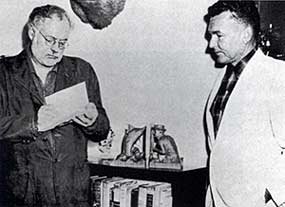Legendary trophy has roots in an American classic
by CASEY O'CONNOR
When Ernest Hemingway's now-iconic story of The Old Man and the Sea was published in 1952, the author sent a signed copy to John Rybovich Jr., a friend since the mid-1930s.
In the mid-'50s, Rybovich and others interested in the Silver Sailfish Derby of the Palm Beaches, Florida's oldest major sailfish competition, were looking for another trophy to add to the event.
Recalling that the first l00-pound sailfish taken in Florida waters was brought aboard Hemingway's boat, the Pilar, off Key West, Rybovich suggested that the Sailfish Club of Florida in Palm Beach commission a trophy designed as bookends holding up Hemingway's book.
Following an exchange of correspondence, Hemingway approved the idea and agreed to inscribe a copy of The Old Man and the Sea that would be presented along with the trophy.
Tony Lopez, a Cuban artist and sculptor, was chosen to carve the bookends of native hardwood. One bookend depicted the old fisherman standing in the center of a small skiff, hand line in his hands. The other bookend showed the head and shoulders of the huge marlin above the surface of the water.
The basis for the bookend designs were the black and white etchings of the struggle between the fisherman and the marlin that appeared in Life magazine to illustrate a feature article on Hemingway's book.
After the first copy of the trophy was completed, Rybovich flew to Cuba for a visit with Hemingway at Finca Vigia, his home southeast of Havana. Rybovich later recalled that Hemingway had been ill. "It was quite a memorable experience. It was his first day out of bed, but he was delighted with the trophy,"Rybovich said.
In the presentation copy of The Old Man and the Sea, Hemingway wrote:
Dear Johnny: I hope you can read this light tackle treatise without too much pain. See you next year. —Ernest.
Hemingway?s entry was duplicated in each book presented as part of the award.

ERNEST HEMINGWAY signs the edition of his novel that was presented as part of the first Old Man and the Sea Award. John Rybovich Jr. traveled to Cuba to show Hemingway the trophy bookends and to have him sign a copy of ?The Old Man and the Sea? in 1956.
"Ernest Hemingway was always a good friend to us," John Rybovich's wife, Kay, recalls. "When we would go down to Cuba for the big fishing tournaments, he would always come down to the docks to see how we were doing and what we had caught. It made us feel very special — because he was Ernest."
The Hemingway trophy was posted in Silver Sailfish Derby competition for the first time in 1956. The Derby committee decided that it would be presented to the angler who ran up the highest sailfish release score in three days of fishing during the four-week event.
Henry Chanin of Atlanta was the first angler to win the award, releasing nine sailfish in three days.
Fidel Castro and the revolution nearly put an end to the Hemingway trophy. When the political climate between Cuba and the United States chilled, tournament officials had only one pair of Lopez's hand-carved bookends on the shelf.
After that set was used, the bookends were carved locally for two years until the trophy was retired in 1962.
A new Hemingway trophy was created for the first Masters Tournament in 1963. Rybovich credited George A. Bass, a member of the Masters Committee and judges panel, with the idea of establishing a new "Old Man and the Sea Trophy" as the major trophy for the Masters.
Mary McClane, a West Palm beach artist and John Rybovich?s sister, created and cast the new bronze trophy.